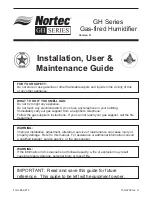
4
1.3 Piping connections
A. Air Inlet - Connect compressed air line from air source
to air inlet. (Reference markings on dryer or, see callout
drawing on pages 18 for air inlet/outlet connection
locations)
Refer to Serial Number Tag for maximum
working pressure. Do not exceed dryer’s Maximum Working
Pressure.
NOTE:
Install dryer in air system at highest pressure possible (e.g.
before pressure reducing valves).
NOTE
:
Install dryer at coolest compressed air temperature possible.
Maximum inlet compressed air temperature: 110°F (43°C).
If inlet air exceeds this temperature, precool the air with an
aftercooler.
B. Air Outlet—Connect air outlet to downstream air lines.
C. By-pass piping—
If servicing the dryer without interrupting the air supply
is desired, piping should include inlet and outlet valves
and an air by-pass valve.
D. Water-cooled models - cooling water inlet and outlet
1. Connect cooling water supply to cooling water inlet.
2. Connect cooling water return line to cooling water
outlet connection.
NOTE:
Strainer and water regulating valve are supplied on
water-cooled models. Also, it is recommended to add water
inlet/outlet temperature and pressure gauges to the water
piping.
1.4 Electrical connections
IMPORTANT:
Use copper supply wires only.
A. Dryer is designed to operate on the
voltage, phase, and frequency listed on
the serial number tag.
B. If dryer is supplied with a cord and plug,
install in a receptacle of proper voltage.
C. Electrical entry on larger dryers is through a hole in the
cabinet. It is located on the right side panel when facing
the front of the unit. Connect power source to the
terminal strip in the electrical enclosure as shown on the
electrical schematic included with the dryer.
If optional disconnect is supplied, use entry hole in
disconnect enclosure.
NOTE:
Refrigeration condensing unit is designed to run
continuously and should NOT be wired to cycle on/off with
the air compressor.
1.5 Moisture separator
A. Model 100:
Separator (and Oil Removal Filter where
applicable) has an internal drain which
automatically discharges collected
condensate.
Models 125-750:
Separator (and Oil Removal Filter where applicable) has an
external drain which automatically discharges collected
condensate.
NOTE:
It may be desirable to pipe the condensate from
the Automatic Drain outlet to a suitable drain.
B. Model 100 with standard panel or optional I-Controller
Level 1 ONLY:
Separator has a knurled fitting with flexible drain tubing
attached. Be sure knurled fitting is tightened by turning
counter-clockwise before operating dryer.
TO CLOSE
TURN COUNTERCLOCKWISE
C. Models 125-750
For manual draining, convenient dryer depressurization,
and drain valve maintenance, a three-way valve assembly
is installed between the drain port on the moisture
separator and the drain valve. Models with the optional
cold coalescing filter are equipped with a separate drain
valve and three-way valve assembly. On Models 125 and
150, the three-way valve is panel mounted inside the
dryer cabinet. On Models 200-750, the three-way valve is
mounted to the bottom of the separator vessel using a
quick disconnect fitting.
Review the following for proper
drain function:
•
Automatic Draining - Valve handle should be
positioned parallel to the valve body (as shown), with
the arrow on the handle pointing toward the drain
valve. In this position, condensate will flow from the
bowl to the drain valve.
•
Drain Isolation (Shutdown) - Valve handle shall be
turned perpendicular to the valve body (rotate 90°).
In this position, condensate flow is shutoff.
MRD100-150
Models 125-150
MRD200-750
Models 200-750
•
Manual Draining - Drain valve handle shall be rotated
slightly past the drain isolation position to allow
throttling through the valve for manual discharge
and depressurization.
Summary of Contents for RNC Series
Page 22: ...22 NOTES...
Page 23: ...23 NOTES...





































